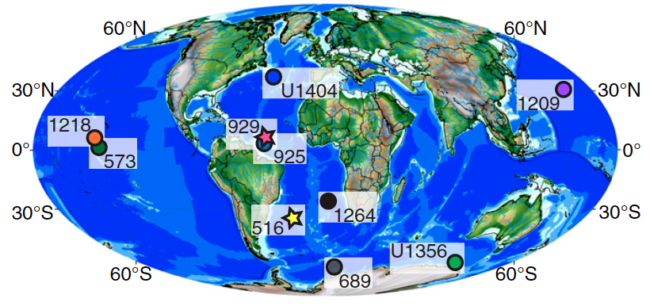Paper: The enigma of Oligocene climate and global surface temperature evolution
Featured image: Figure 1 from O’Brien et al. (2020). Paleogeographic reconstruction of the late Oligocene world, with continents and oceans in slightly different positions than today. Symbols indicate paleo-locations of ocean sediments that these scientists discuss in their paper, with stars indicating sites where they estimated Oligocene temperatures.
Authors: Charlotte L. O’Brien, Matthew Huber, Ellen Thomas, Mark Pagani, James R. Super, Leanne E. Elder, Pincelli M. Hull
We know that the amount of carbon dioxide in the atmosphere strongly affects climate –and temperature – on Earth. As carbon dioxide concentrations increase, so does average global temperature; this pattern is clear from direct historical measurements and ice core records going back hundreds of thousands of years. Nevertheless, it’s important to understand how this relationship operated in the past (for example, during times when there was less ice in the cold polar regions of the globe). A new study suggests that, millions of years in the past, the simple relationship between carbon dioxide and temperatures may not have been so clearcut.
Using varied and intricate methods, scientists have constructed many temperature estimates from the geological record that sketch out a history of warming and cooling on Earth. However, we have not previously known much about how temperatures on Earth changed over the Oligocene epoch, which lasted from 34-23 million years ago. Geochemist Dr. Charlotte O’Brien and her colleagues filled this gap by reconstructing sea surface temperatures over this time period using fossilized molecular remains of microorganisms buried in ocean sediments.

The authors harnessed previous knowledge of how certain lipids (types of carbon-rich biomolecules) are produced in microscopic ocean-living Thaumarchaeota, a subset of Archaea (one of the three domains of the tree of life, along with Bacteria and Eukaryota). The molecular structure of these lipids is sensitive to the temperature of seawater, so the lipid molecules preserved deep under the modern seafloor tell a story of ocean temperatures going back in time! The authors measured these lipid structures from Oligocene-age ocean sediments under the seafloor in the equatorial Atlantic Ocean and off the southernmost coast of Brazil. They then combined their new data with previous temperature estimates and computer modeling to picture climate on Earth during the Oligocene.
O’Brien et al. found that sea surface temperatures across the Oligocene remained nearly as high as temperatures previously estimated for the earlier, hotter time period of the late Eocene (56-34 million years ago). Ocean temperatures remained high even though carbon dioxide in the atmosphere is estimated to have dropped significantly from the Eocene into the Oligocene. In addition, carbon dioxide levels are thought to have lowered over the latest Oligocene, but the new temperature estimates show warming oceans over this time period.
These findings are puzzling because they suggest the opposite pattern to our modern-day observations that drops in carbon dioxide would result in cooling temperatures (and vice versa). In addition, the authors’ computer models consistently predicted cooler sea surface temperatures in polar regions during the Oligocene than what their compiled temperature data actually showed. These unexpected patterns indicate that the scientific community needs to understand why elevated ocean temperatures in the Oligocene were not accompanied by expected sustained high levels of carbon dioxide. Solving this puzzle could involve re-examining how climate models treat other aspects of climate further back in time, such as the role of clouds and ocean circulation in setting Earth’s surface temperatures.
Ancient ocean temperatures outline a puzzling period in Earth’s climate history by Lloyd Anderson is licensed under a Creative Commons Attribution 4.0 International License.

